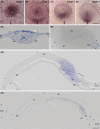A network of transient domains for breaking symmetry during anterior-posterior axis formation in the porcine embryo
- PMID: 39377464
- PMCID: PMC12344223
- DOI: 10.1002/dvdy.739
A network of transient domains for breaking symmetry during anterior-posterior axis formation in the porcine embryo
Abstract
Breaking radial symmetry for anterior-posterior axis formation is one of the key developmental steps of vertebrate gastrulation and is established through a succession of transient domains defined by morphology or gene expression. Three such domains were interpreted recently in the rabbit to be part of a "three-anchor-point model" for axis formation. To answer the question as to whether the model is generally applicable to mammals, the dynamic expression patterns of four marker genes were analyzed in the pig, where gastrulating epiblast forms from half the inner cell mass: EOMES and PKDCC transcripts display decreasing expression intensities in the anterior hypoblast and-together with WNT3-increasing intensity in the anterior streak domain and the node; TBX6 expression changes from an initial central expression to exclusive expression in the posterior extremity of the primitive streak. The anterior streak domain has thus a molecular footprint similar to the one in the rabbit, the end node shares TBX6 between the species, while the anterior hypoblast-mirroring specific porcine epiblast derivation and fate-is marked by PKDCC instead of WNT3. The molecular similarities in transient domains point to conserved mechanisms for establishing the mammalian anterior-posterior axis and, possibly, breaking radial symmetry.
Keywords: anterior visceral endoderm; gastrulation; gene expression; pig; primitive streak; radial symmetry.
© 2024 The Author(s). Developmental Dynamics published by Wiley Periodicals LLC on behalf of American Association for Anatomy.
Conflict of interest statement
The authors declare no conflicts of interest.
Figures








References
-
- Stern CD. Gastrulation in the chick. In: Stern CD, ed. Gastrulation: From Cells to Embryo. 1st ed. Cold Spring Harbor Laboratory Press; 2004.
-
- Viebahn C. Gastrulation in the rabbit. In: Stern CD, ed. Gastrulation: From Cells to Embryo. 1st ed. Cold Spring Harbor laboratory Press; 2004.
-
- Eakin GS, Behringer RR. Gastrulation in other mammals and humans. In: Stern CD, ed. Gastrulation: From Cells to Embryo. 1st ed. Cold Spring Harbor Laboratory Press; 2004.
MeSH terms
Substances
LinkOut - more resources
Full Text Sources

